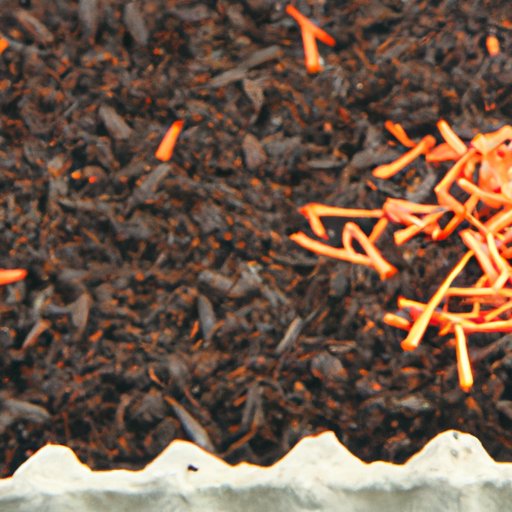
A Beginner’s Guide to Planting Marigold Seeds: Tips and Techniques
Marigolds are one of the most popular and easy-to-grow flowers in the garden; they add a burst of bright color and attract beneficial pollinators to your garden easily. However, if you are new to gardening, you may need some guidance on how best to plant marigold seeds. This article is intended to help you overcome the challenges of planting marigold seeds and provide you with tips and techniques to create a thriving and healthy marigold garden.
A Step-by-Step Guide to Planting Marigold Seeds
Before planting, it is essential to prepare the soil. Marigolds thrive in well-drained soil with a pH of 6.0 to 7.0, so loosen the soil to a depth of 6 to 8 inches. Next, add a few inches of organic matter such as compost and manure to improve soil texture and fertility.
The ideal time to sow marigold seeds is after the last frost in spring. To plant the seeds, sprinkle them thinly on the soil surface, cover with a light layer of soil, and gently press down. Plant the seeds around 6 inches apart in rows that are 8-10 inches apart. The soil should be moist but not soaked, keep watering the bed with a gentle spray of water every few days to keep seeds moist until they germinate.
To give the plants ample room to grow, it is essential to thin them out when they produce their first true leaves. Leave one marigold for every 6 inches, and use the rest as seedlings. You can fertilize the young plants using a balanced fertilizer as per the package instructions to promote vigorous growth.
Marigolds are generally pest-resistant, but you can protect the young plants from slugs, snails, and other pests by sprinkling diatomaceous earth around the base of the plants or using organic pest control sprays like diluted neem oil or insecticidal soaps.
Tips for Planting Marigold Seeds in Containers
If your garden has limited space or if you want to add some marigolds to your balcony, growing them in containers is a great idea. You can plant marigold seeds in pots after the last frost and move them to a sunny location.
You can use any container that has drainage holes, including plastic buckets, ceramic pots, or wooden boxes. Fill the containers with well-draining potting soil. If you want to keep the size of the plant manageable, you can choose smaller varieties suited for container gardening. When watering, be sure to water deeply and ensure the soil dries out between watering.
To prevent root rot, you should ensure that there is good drainage in your pots with adequate drainage holes to remove excess water. Also, consider adding one tablespoon of compost every few weeks, which will provide your marigold with extra nutrients to grow healthy.
Choosing the Best Location for Marigold Seeds
Marigolds grow well in both partial shade and full sun, but the different varieties have varying light and soil requirements. If you want to grow marigolds in large numbers, plant them in locations that receive full sun for six or more hours a day. Marigolds thrive in light, well-drained soil but are more tolerant of heavier soils than some other flowers.
Some varieties of marigold, like the French and Burro, are shorter and more suited to smaller spaces, while the taller African marigolds grow up to three feet tall and are best suited for the back of your garden. Checking the seed packet to determine the final plant height is an essential step in making a location choice.
Caring for Marigold Seedlings
Marigolds are quite easy to care for once established and can tolerate heat and dryness well. During their early stages, they require regular gentle watering to keep the soil moist but not overly wet. Once established, water them every two weeks as marigolds are drought-resistant. Deadhead the spent flowers continuously to encourage new blooms and control plant growth.
To keep the plants looking strong and healthy, fertilize them monthly with high phosphorus fertilizer to promote blooming. Spread one tablespoon of fertilizer around the plants and follow the package instructions regarding application amounts.
Using Marigold Seeds to Attract Pollinators
Marigolds are excellent for attracting bees and butterflies to the garden. They are one of the few products that deter nematodes and add color to your garden while encouraging pollination.
Certain types, like the Tagetes, are particularly attractive to pollinators and can also help control pests like whiteflies, mosquitoes, and certain beetles. When planting marigolds to attract pollinators, consider planting in masses for the plants to serve as optimal landing pads for the insects.
Choosing the Right Kinds of Marigold Seeds
Marigolds come in different sizes and colors, and some are more resistant to pests and diseases than others. When choosing the right kind of marigold seed, consider the amount of light they require, soil pH, and soil type.
For instance, the French Marigold variety is perfect for warm, dry conditions and repels insects commonly associated with leafy green vegetables. The African Marigold has attractive, large blooms but requires full sun. Marigold seeds are inexpensive, and you can try out different cultivars to see what works best in your garden.
Conclusion
Marigolds are a colorful and easy-to-grow addition to your garden that brings a great addition of color and insect-friendly features. With a little care and attention, you can enjoy them for many years, and your efforts will repay your garden with bright colors and attracting beneficial pollinators. The tips and techniques highlighted in this article should make planting marigold seeds easy and effective, giving you an opportunity to breathe life and color into your garden.





